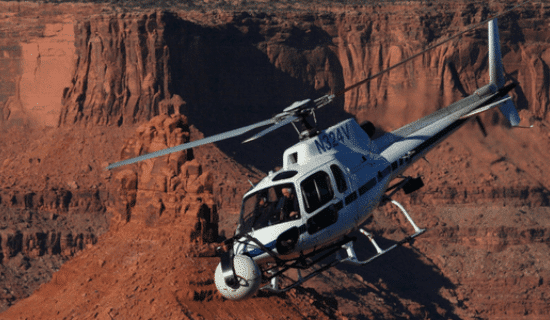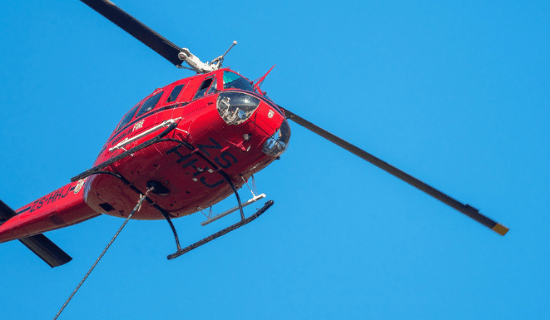Helicopter Crash Statistics: What You Need to Know
The sudden death of basketball legend Kobe Bryant in January 2020 brought the risks of helicopter travel to the forefront of the news as well as the minds of many Americans who followed the tragic story. Bryant died in a helicopter crash that killed the pilot and all eight passengers, including Bryant and his young daughter Gianna. Five months after the crash, the exact factors that caused the accident had still not officially been determined, but low visibility due to fog at the time of the crash was cited as a likely cause. The unfortunate truth, however, is that helicopter crash statistics have long shown this mode of transportation to be risky and dangerous, and helicopter fatalities are not uncommon.
When looking at aviation crash statistics, it’s important to know that these accidents are calculated by how many accidents occur for every 100,000 hours flown. From the year 2016 to 2017, fatal helicopter accident rates jumped from 0.54 accidents per every 100,000 flight hours to 0.6 accidents per every 100,000 flight hours. This number increased again in 2018 to 0.72 fatal accidents for every 100,000 hours. Additionally, the number of fatalities per 100,000 flight hours rose from 1.02 in 2017 to 1.64 in 2018.
In 2019, there were 122 helicopter accidents, 24 of which were fatal, resulting 51 fatalities. While there is an overall declining trend in helicopter accidents and helicopter accident fatalities when looking at the past twenty years, not enough precautions are being taken to prevent these tragedies.
Helicopter travel is one of the riskiest forms of transportation due to an assortment of factors including variations in pilot experience and training, unsafe or rapidly changing weather conditions, variations in terrain and visibility along flight routes, mechanical malfunctions, shortfalls in maintenance protocols, and lack of safety technologies and industry regulations. To put it simply, helicopters are more likely to crash than most other types of aircraft; this is true for tour and medical helicopters as well as helicopters used in military and search-and-rescue missions.
What is it that makes helicopters so dangerous in comparison to other types of air travel? While we have already mentioned some of the reasons, the answer is actually quite complex, as it involves many different factors, starting with the simple fact that helicopters are built with more moving parts than airplanes; this increases the potential for one or more of those parts to malfunction. There are also many different types of and uses for helicopters, as well as wide variations in the quality of aircraft and the levels of pilot training and experience.
Military and medical helicopter pilots, for example, are typically highly trained and often fly higher-quality aircraft, while tour helicopter pilots might be held to lower standards for training and experience and might also be piloting an aircraft that does not meet the same quality standards. Having less training and experience increases the likelihood that a pilot might make errors during flight that could lead to a crash. Similarly, lower-quality helicopters are more likely to experience malfunctions that a less skilled pilot might not be able to manage mid-flight.
The most common causes of helicopter crashes include:
- Inadequate maintenance and inspection protocols, or failure to follow protocols.
- Inadequate pilot training, including safety training.
- Operating a helicopter in low visibility, inclement weather, or other unsafe conditions.
- Problems in the helicopter’s design, manufacturing, or quality control.
- Lack of adequate safety features, regulations, or oversight in the small-aircraft industry.
Many helicopter crashes are caused by human error in one or more of the above areas. Furthermore, helicopter accidents have a high likelihood of tragic consequences, since helicopters themselves are relatively small and unprotected; crashes are likely to result in serious injury or death for the people on board.
While groups like the Federal Aviation Administration (FAA) and the U.S. Helicopter Safety Team have worked together for years to implement increased regulations and safety measures in response to ongoing helicopter crash data—such as pushing for all helicopters to be equipped with crash-resistant fuel systems and recommending that pilots use flight simulators in training—there is still plenty of room for improvement. This is especially true in the areas of tourist and commercial helicopter safety.
Helicopter sightseeing tours are one of the major areas of concern in helicopter safety. Hawaii is one of the biggest tourist destinations in the U.S., and the beautiful, unique and often rugged terrain of its islands is a major part of what attracts tourists to helicopter sightseeing tours. But Hawaii helicopter crash statistics show that these tours are not without significant risk, in part due to that rugged terrain, which presents hazards that inexperienced pilots may not be able to navigate safely. When reviewing statistics, you can see that 2019 was an especially deadly year for helicopter tour crashes in Hawaii; it ended with a crash in December 2019 on Kauai that killed the pilot along with all six of his passengers, three of whom were children.
When helicopters crash, it is often due to human error at some stage in the helicopter’s design, manufacturing, maintenance, or operation. This is why it is important after a tragic helicopter accident to determine who was at fault—whether that was the pilot, the manufacturer, the maintenance crew, the operating company, or another party—so the correct parties can be held liable, and victims and their families can be compensated for their losses.
In addition to Hawaii, the Grand Canyon is another popular spot for tourists to view the beautiful sights from above and, like Hawaii, Grand Canyon helicopter crash statistics paint a grim picture.
 Grand Canyon Helicopter Crash Statistics
Grand Canyon Helicopter Crash Statistics
Overall helicopter crash statistics paint a picture of significant risk for people who ride in helicopters, especially those operated by newer, less-skilled pilots. But helicopter crash statistics can vary according to location, weather patterns, topography, and other factors. Grand Canyon helicopter crash statistics show that sightseeing tours over this major tourist landmark are uniquely dangerous, in part because of the simple fact that the Grand Canyon is such a popular tourist destination, so the airspace over this natural wonder is crowded. There are thousands of helicopter rides each year over the Grand Canyon; increased numbers of aircraft sharing the same space automatically increases the chances that helicopter tour accidents will occur.
Furthermore, the Grand Canyon’s unique topography poses challenges even for experienced pilots, such as abrupt wind changes caused by the canyon’s steep, rugged precipices. Since helicopters are fundamentally unstable aircraft, extensive training and skill are required for pilots to respond appropriately to sudden changes in wind patterns, weather, or visibility mid-flight. Helicopter tour companies are notorious for trying to save money by employing less experienced pilots, failing to enforce stringent maintenance protocols, or choosing not to implement recommended but optional safety measures.
In the past ten years, seven helicopter tour accidents occurred in Arizona, leading to five fatalities and nine injured passengers. One of these accidents occurred in February 2018 and was the latest in a long history of fatal helicopter accidents at the Grand Canyon. At the time of the crash, the company operating the flight, Papillon Airways, was already under investigation by the National Transportation Safety Board (NTSB) for several other fatal crashes in the previous two decades. While certain restrictions had already been imposed by the FAA to reduce the likelihood of accidents at the Grand Canyon, such as barring helicopters from coming within 500 feet of obstacles or dipping below the rim of the canyon, these restrictions weren’t enough to prevent yet another fatal crash.
Unfortunately, while the NTSB and the FAA are major organizations responsible for investigating and regulating various types of transportation in the U.S., including helicopter travel, they don’t always work together, and have at times even been at odds. For example, following certain helicopter crash investigations, the NTSB has sometimes made recommendations for increased regulations that the FAA has failed to pursue. When resisting recommendations for greater oversight and regulatory control, the FAA has cited, among other issues, concerns that overly strict regulations might harm smaller tour companies and other businesses in the industry.
All of this means that despite the strides that have been made over the past decades in terms of increased safety features and pilot training and greater oversight in the aviation industry as a whole, there still isn’t enough being done to prevent catastrophic accidents from occurring—and the cost is human lives.
Medical Helicopter Crash Statistics
Air medical services are a critical component in saving lives during an emergency. Air ambulances can transport critically ill or injured patients to emergency care facilities, quickly deliver donor organs to hospitals, or bring specialized medical personnel to patients in need. Since these types of aircraft might be required at any given location, at any hour, and in any type of weather, medical helicopter pilots are routinely required to fly in dangerous conditions, such as at night, in foggy or stormy weather, or at low altitude over remote, rugged terrain. While these factors are a necessary part of the job, and pilots of these aircraft are typically highly trained and experienced, medical helicopter crash statistics show that this type of transport is significantly risky for both the pilots and their passengers.
Medical helicopter crash statistics have raised significant safety concerns regarding this industry over the past two decades. The total number of emergency medical services helicopters in operation has increased over time, along with the number of flight hours that medical helicopter operations have flown. Unfortunately, the overall accident rate for these aircraft has also risen in recent years, prompting the NTSB to launch special investigations into these crashes.
After concluding an investigation of multiple medical helicopter crashes that had occurred between January 2002 and January 2005, the NTSB reported finding several significant issues, including a lack of important safety technologies that would help medical helicopter pilots avoid crashes, such as terrain awareness and warning systems (TAWS). During this period, one in every fifty medical helicopters in the U.S. medical helicopter fleet was involved in a crash.
A January 2019 medical helicopter crash in Ohio, which killed the pilot and two nurses aboard, spurred another NTSB investigation that revealed lax safety measures and deteriorating weather conditions had together contributed to the crash. Increased safety regulations and requirements for safety technologies like TAWS can mean the difference between life and death for medical helicopter pilots and their passengers. Until regulations require all medical helicopters to be equipped with the latest safety technologies, all pilots of these aircraft are required to undergo extensive safety training, and all medical helicopter companies begin adhering to a high standard of safety measures and protocols, helicopter accidents will continue to occur at a higher rate, and people will continue suffering catastrophic losses as a result.
Slack Davis Sanger’s Helicopter Accident Attorneys Work Tirelessly to Bring Our Clients Justice
Although some efforts have been put in place to make helicopters a less dangerous mode of transportation, not enough is being done to regulate this industry. Our team of aviation attorneys is composed of licensed pilots, as well as a former NASA aerospace engineer, all of which have a deep understanding of helicopter laws and regulations, in addition to understanding the technical aspects of these accidents. Our team is compassionate and empathetic, and we will use every resource at our disposal to ensure our clients receive the compensation they deserve, so they can begin to move forward after a tragic accident.

The firm handles cases involving catastrophic personal injuries and deaths. Our work spans three decades of handling airplane and helicopter crashes, truck and car accidents, oilfield and construction accidents, and other devastating accidents. We try lawsuits throughout the country in both federal and state courts and have recovered hundreds of millions of dollars for our clients. To date, we have handled or tried cases in 47 states, read more about our attorneys and firm.

